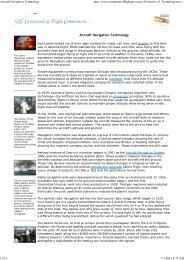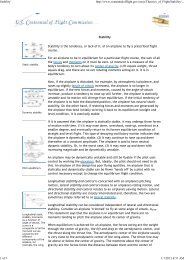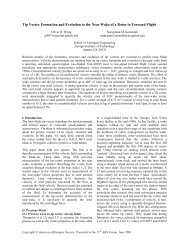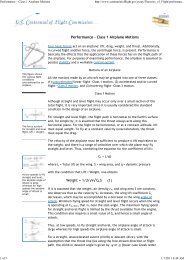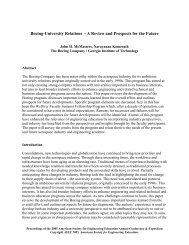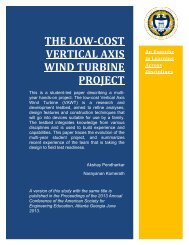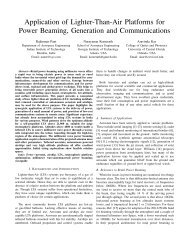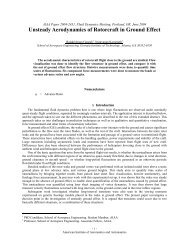Skin-Friction Drag An important aerodynamic force during low ...
Skin-Friction Drag An important aerodynamic force during low ...
Skin-Friction Drag An important aerodynamic force during low ...
- No tags were found...
Create successful ePaper yourself
Turn your PDF publications into a flip-book with our unique Google optimized e-Paper software.
<strong>Skin</strong>_<strong>Friction</strong>http://www.centennialofflight.gov/essay/Theories_of_Flight/<strong>Skin</strong>_Frict...1 of 3 1/1/2011 8:35 AM<strong>Skin</strong>-<strong>Friction</strong> <strong>Drag</strong>Pressure andviscous <strong>force</strong>s. Inaddition to thepressure <strong>force</strong>s thatact everywherenormal to(perpendicular to) abody immersed in amoving fluid,viscous <strong>force</strong>s arealso present. It isthese viscous <strong>force</strong>sthat modify theideal fluid lift andhelp create the realfluid drag.Figure (a) showsinviscid f<strong>low</strong> (thefluid is ideal) along aflat plate. Under thiscondition, the fluidsimply slips over thesurface with velocityV. No drag results ifthe fluid isfrictionless(inviscid). Figure (b)shows viscous f<strong>low</strong>along a flat platefound underconditions of realfluid f<strong>low</strong>. A verythin film of fluidadheres to thesurface. At thesurface of a body,point B, the f<strong>low</strong>velocity is zero. Asone moves awayfrom the body, thevelocity of the fluidgradually increasesuntil at some point<strong>An</strong> <strong>important</strong> <strong>aerodynamic</strong> <strong>force</strong> <strong>during</strong> <strong>low</strong>-speed subsonic flight is the shear<strong>force</strong> (the sideways <strong>force</strong> or internal friction) caused by viscous airf<strong>low</strong> over thesurfaces of the vehicle. This shear <strong>force</strong> is referred to as the skin-friction <strong>force</strong>or skin-friction drag and depends strongly on the Reynolds number, surfaceroughness, and pressure gradients. In addition to the pressure <strong>force</strong>s that acteverywhere perpendicular to (normal to) a body in moving air, viscous <strong>force</strong>sare also present. It is these viscous <strong>force</strong>s that modify the lift that would existunder ideal conditions (air is inviscid and incompressible) and help create thereal drag.If the airf<strong>low</strong> were ideal, that is, inviscid, the air would simply slip over thesurface of a smooth plate with velocity V¥. At all points along the surface of theplate, the velocity distribution (that is, the variation in velocity as one movesperpendicularly away from the surface) would be a uniform constant value ofV ∞ . No drag would result if the airf<strong>low</strong> were frictionless (inviscid).Under real conditions, however, a very thin film of air molecules adheres to thesurface. This is the very <strong>important</strong> no-slip condition. It states that at the surfaceof a body, the airf<strong>low</strong> velocity is zero. As one moves away from the body, thevelocity of the air gradually increases until, at some point, the velocitybecomes a constant value; in the case of a flat plate this value is V¥. The layerof air where the velocity is changing from zero to a constant value is called theboundary layer. Within the boundary layer, there are relative velocitiesbetween the layers and an internal friction is present. This internal frictionextends to the surface of the body. The cumulative effect of all these friction<strong>force</strong>s is to produce drag on the plate. This drag is referred to as skin-frictiondrag.Initially, near the leading edge of a flat, smooth plate, one has a laminar f<strong>low</strong>(the f<strong>low</strong> is layered) and the boundary layer also is steady and layered—hence, alaminar boundary layer. As one moves farther downstream, viscosity continuesto act, and the laminar boundary layer thickens as more and more air is s<strong>low</strong>eddown by internal friction. Eventually, a point is reached on the plate where thelaminar boundary layer undergoes transition and becomes a turbulent boundarylayer. As is usual for turbulent f<strong>low</strong>, there is random motion in the boundarylayer as well as the downstream-directed motion. There is no slip at the surfaceof the plate. <strong>An</strong>other <strong>important</strong> difference from the laminar boundary layer isthe fact that the velocity builds up more quickly as one moves away from thewall, although the total boundary-layer thickness is greater. The turbulentboundary layer farther away from the wall reenergizes the s<strong>low</strong>er moving airnearer the wall. This condition can be seen by comparing the profile of thelaminar boundary layer with the profile of the turbulent boundary layer.The Reynolds number has an <strong>important</strong> effect on the boundary layer. As theReynolds number increases (caused by increasing the airf<strong>low</strong> speed and/ordecreasing the viscosity), the boundary layer thickens more s<strong>low</strong>ly. However,even though the Reynolds number becomes large, the velocity at the surface ofthe body must be zero. Thus, the boundary layer never disappears.It is interesting to note that a typical thickness of the boundary layer on an
<strong>Skin</strong>_<strong>Friction</strong>http://www.centennialofflight.gov/essay/Theories_of_Flight/<strong>Skin</strong>_Frict...2 of 3 1/1/2011 8:35 AMA the velocitybecomes a constantvalue V. The layer offluid where thevelocity is changingfrom zero to aconstant value isknown as theboundary layer.Figure (c) compareslaminar andturbulent f<strong>low</strong>s. Asis usual for turbulentf<strong>low</strong>, there is arandom motion inthe boundary layer.Real fluid f<strong>low</strong> aboutan airfoil. Thethickness of theboundary layers andwake are greatlyexaggerated. Thebottom f<strong>low</strong> along<strong>low</strong>er surface is thesame as on theupper surface.Figure (a) comparesthe ideal fluid casestatic-pressuredistribution at theairfoil surface andcenterlinestreamline with thereal fluid case.Figure (b) illustratesthat, in the idealfluid case, the netstatic-pressure<strong>force</strong> acting on thefront surface of theairfoil (up to theshoulder) parallel tothe free streamexactly opposesand cancels thatacting on the rearsurfaces of theairfoil. In the realfluid case, shown infigure (c), the netresult is a drag <strong>force</strong>due to theasymmetricpressure distributionaircraft wing is generally less than a centimeter (2.5 inches). Yet, the velocitymust vary from zero at the surface of the wing to hundreds of meters per secondat the outer edge of the boundary layer. It is evident that tremendous shearing<strong>force</strong>s (internal friction) must be acting in this region. This gives rise to theskin-friction drag.Applied to an airfoil in a real airf<strong>low</strong>, the same free-stream velocity V¥ andfree-stream static pressure p¥ apply. The field of air ahead of the airfoil is onlyslightly modified and for all practical purposes, the velocities and staticpressures are the same as for the ideal fluid case. Again a stagnation point (apoint with no motion) occurs at the leading edge of the airfoil and the pressurereaches its maximum value of p t at this point (total or stagnation pressure).From this point on along the airfoil, the picture changes.As noted earlier in the example of the flat plate, a boundary layer begins toform because of viscosity. This boundary layer is very thin and outside of it, thef<strong>low</strong> acts very much like that of an ideal fluid. Also, the static pressure actingon the surface of the airfoil is determined by the static pressure outside theboundary layer. This pressure is transmitted through the boundary layer to thesurface and thus acts as if the boundary layer were not present at all. But theboundary layer feels this static pressure and will respond to it.Over the front surface of the airfoil up to the shoulder, an assisting favorablepressure gradient exists (pressure decreasing with distance downstream). Theairf<strong>low</strong> speeds up along the airfoil. The f<strong>low</strong> is laminar and a laminar boundarylayer is present. This laminar boundary layer grows in thickness along theairfoil. When the shoulder is reached, however, the air molecules are movings<strong>low</strong>er than in the ideal fluid case. This is an unfavorable condition because theprevious ideal f<strong>low</strong> just came to rest at the trailing edge of the airfoil. It wouldappear now, with viscosity present, that the f<strong>low</strong> will come to rest at somedistance before the trailing edge is reached.As the airf<strong>low</strong> moves from the shoulder to the rear surface of the airfoil, thestatic-pressure gradient is unfavorable (increasing pressure with downstreamdistance). The air molecules must push against both this unfavorable pressuregradient and the viscous <strong>force</strong>s. At the transition point, the character of theairf<strong>low</strong> changes and the laminar boundary layer quickly becomes a turbulentboundary layer. This turbulent boundary layer continues to thicken downstream.Pushing against an unfavorable pressure gradient and viscosity is too much forthe airf<strong>low</strong>, and at some point, the airf<strong>low</strong> stops completely. The boundarylayer has stalled short of reaching the trailing edge. (Remember that the airf<strong>low</strong>reached the trailing edge before stopping in the ideal fluid case.)This stall point is known as the separation point. All along a line starting fromthis point outward into the airf<strong>low</strong>, the airf<strong>low</strong> is stalling. Beyond this line, theairf<strong>low</strong> is actually moving backward, upstream toward the nose before turningaround. This is a region of eddies and whirlpools and represents “dead” air thatis disrupting the f<strong>low</strong> field away from the airfoil. Thus, the airf<strong>low</strong> outside thedead air region is <strong>force</strong>d to f<strong>low</strong> away and around it. The region of eddies iscalled the wake behind the airfoil.Up to the separation point, the difference between the static-pressuredistribution for ideal fluid f<strong>low</strong> and real airf<strong>low</strong> is not very large but onceseparation occurs, the pressure field in greatly modified. In the ideal fluid case,the net static-pressure <strong>force</strong> acting on the front surface of the airfoil (up to theshoulder) parallel to the free stream exactly opposed and canceled that actingon the rear surfaces of the airfoil. Under real airf<strong>low</strong> conditions, however, thissymmetry and cancellation of <strong>force</strong>s is destroyed. The net static-pressure <strong>force</strong>
<strong>Skin</strong>_<strong>Friction</strong>http://www.centennialofflight.gov/essay/Theories_of_Flight/<strong>Skin</strong>_Frict...3 of 3 1/1/2011 8:35 AMcalled pressuredrag. Figure (d)illustrates the liftand drag for anairfoil producing liftin both an ideal andreal fluid case.acting on the front surface parallel to the free-stream direction now exceedsthat acting on the rear surface. The net result is a drag <strong>force</strong> due to theasymmetric pressure distribution called pressure drag. This is a drag in additionto the skin-friction drag due to the shearing <strong>force</strong>s (internal friction) in theboundary layer. Additionally, the modification of the static-pressure distributioncauses a decrease in the pressure lift from the ideal fluid case. The effect ofviscosity is that the lift is reduced and a total drag composed of skin-frictiondrag and pressure drag is present. Both of these are detrimental effects.It should be emphasized that similar processes are occurring on all thecomponents of the aircraft to one degree or another, not only the airfoil.Thus, the effects of a real fluid f<strong>low</strong> are the result of the viscosity of the fluid.The viscosity causes a boundary layer and, hence, a skin-friction drag. The f<strong>low</strong>field is disrupted because of viscosity to the extent that a pressure drag arises.Also, the net pressure lift is reduced.—Adapted from Talay, Theodore A. Introduction to the Aerodynamics of Flight.SP-367, Scientific and Technical Information Office, National Aeronautics andSpace Administration, Washington, D.C. 1975. Available athttp://history.nasa.gov/SP-367/cover367.htmFor Further Reading:<strong>An</strong>derson, Jr., John D. A History of Aerodynamics. Cambridge, England:Cambridge University Press, 1997.Hewitt, Paul G. Conceptual Physics. Sixth Edition. Glenview, Ill.: Scott,Foresman and Company, 1989.Wegener, Peter P. What Makes Airplanes Fly? New York: Springer-Verlag, 1991.EducationalOrganizationInternationalTechnology EducationAssociationNational Council ofTeachers ofMathematicsNational ScienceEducation StandardsStandard Designation(where applicableStandard 2N/AContent Standard BContent of StandardStudents will develop anunderstanding of the coreconcepts of technology.Instructional programsfrom pre-kindergartenthrough grade 12 shouldenable all students tounderstand measurableattributes of objects andthe units, systems, andprocesses of measurementAs a result of activities ingrades 9-12, all studentsshould develop anunderstanding of motionsand <strong>force</strong>s.Home | About Us | Calendar | Wright Brothers History | History of Flight | Sights & Sounds | Licensed Products | Education | Links | Sitemap


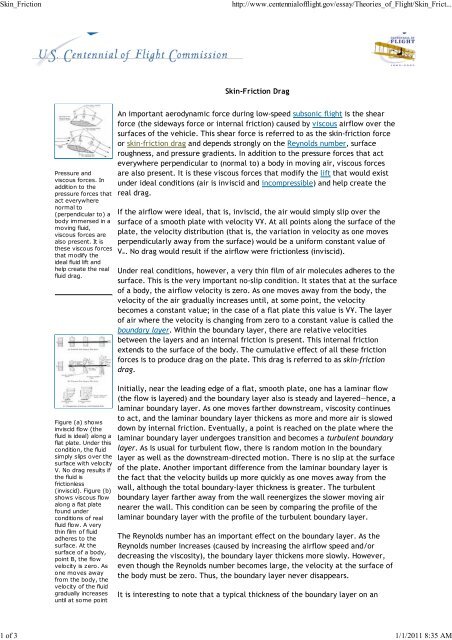
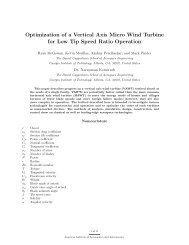
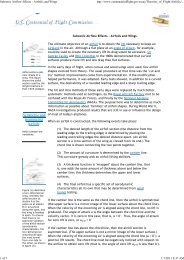

![p density of fluid, kg/m3 [Greek letter rho] V mean velocity of fluid, m ...](https://img.yumpu.com/50595898/1/184x260/p-density-of-fluid-kg-m3-greek-letter-rho-v-mean-velocity-of-fluid-m-.jpg?quality=85)
